This is the Trumpeter 01517 kit in 1/35 scale, of the ‘German Railway Gondola’.
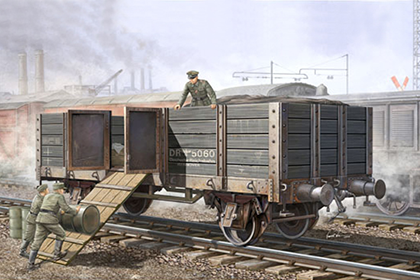
History
Manufacturer
Where I got it
- Stoppel Hobby (June 2014)
This is the Trumpeter 01517 kit in 1/35 scale, of the ‘German Railway Gondola’.

This is the Trumpeter 01518 kit in 1/35 scale, of the ‘German Railway Gondola – Lower sides’.
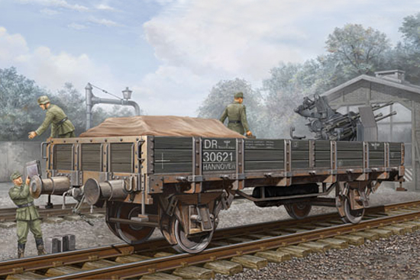
Half tracks, soft skin vehicles and light armor like the Marter III were seen on these cars. They were used throughout the span of the war. These cars were often sand bagged and used with AA units for Air cover.
This is the Trumpeter 00207 kit in 1/35 scale, of the ‘German 280mm, Railroad Gun, Leopold’.
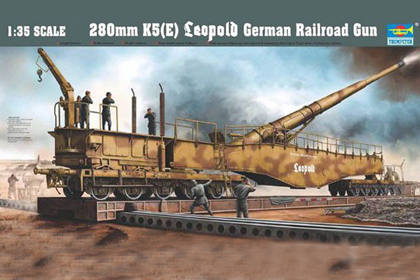
By 1918 the railway gun was in use by nearly all the major combatants and among them Germany was the major country with this powerful armament. But after 1918 the Treaty commissions scrapped all the German railway artillery. After the NSDAP came to power in 1933 the German military began a major rearmament program and on the list of weapons needed were modern railway guns. Before 1933 a great deal of theoretical work had been carried out on future railway guns but it was not until 1934 that the first practical work began on two new designs. In time these were to emerge as the K5 (E) and K12 (E).
The Leopold had an unconfirmed range of 11 miles and fired a pre-engraved projectile weighing approximately 550 pounds. It is fired from a turntable affording a 360degree traverse. The gun has a 70-foot 8-inch barrel held in a sleeve-type cradle. The barrel recoil mechanism, fitted between two arms projecting downward from the cradle, consists of two hydro pneumatic cylinders and a single hydraulic buffer cylinder. A central jack helps support the tremendous weight of the gun and carriage, which amounts to around 230 tons and also serves as a central pivot for the turntable.
The German Leopold Gun was the largest weapon, which lobbed shells at American troops at “Anzio Beach”. The Leopold supported by 24 railcar wheels, was mounted on railroad tracks, which led in and out of mountain tunnels. When not firing, the gun was rolled back into the tunnels out of the sight of Allied reconnaissance. Although both guns had been extensively damaged, Allied forces were able to salvage the Leopold and after reconstruction of the railway, moved the gun to Naples for shipment to the United States. “Anzio Annie” as the gun was known to the Allied troops at Anzio, is the only German railroad gun known to have survived World War II. The Leopold is currently on display at the Aberdeen Proving Ground in Aberdeen, Maryland.
This is the Trumpeter 01516 kit in 1/35 scale, of the ‘German Panzerjäger-Triebwagen 51’.

There were only three of this railcar made (No. 51-53) and all were found at the factory by Allied forces, but it is questionable whether any ever went into service.
This is the Trumpeter 01511 kit in 1/35 scale, of the ‘German Kanonen und Flakwagen’.
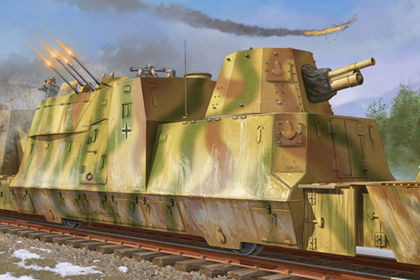
The two halves of the train, before and behind the locomotive were identical and consisted of one artillery car with one 10cm le.F.H 14/19(p) gun, one command and infantry car and one artillery and anti-aircraft car with one 7.62cm F.K.295/l(r) and one 2cm anti-aircraft quadruple unit.
This is the Trumpeter 00219 kit in 1/35 scale, of the ‘German Panzerlok BR57 Armoured Locomotive’.
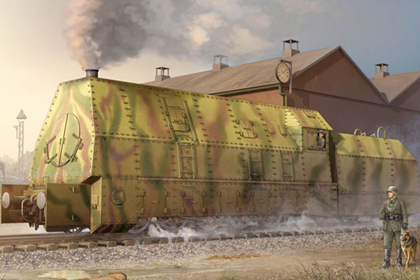
The Deutsche Reichsbahn-Gesellschaft (DRG), or German National Railway between 1920 and 1945, saw armored trains as a way to preserve and advance a military presence. By keeping a strong military face on this state owned railroad.
The BR57 armored trains locomotive was actually based on the Prussian series G10 locomotive first built in 1910 and featuring an 0-10-0 wheel arrangement.
This is the Trumpeter 01510 kit in 1/35 scale, of the ‘German Kommandowagen’.
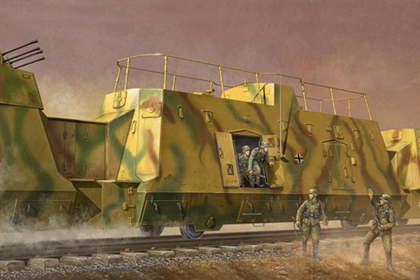
The two halves of the train, before and behind the locomotive were identical and consisted of one artillery car with one 10cm le.F.H 14/19(p) gun, one command and infantry car and one artillery and anti-aircraft car with one 7.62cm F.K.295/l(r) and one 2cm anti-aircraft quadruple unit.
This is the Trumpeter 00209 kit in 1/35 scale, of the ‘German Mörser Karl-Gerat 040/041 on railway transport carrier’.
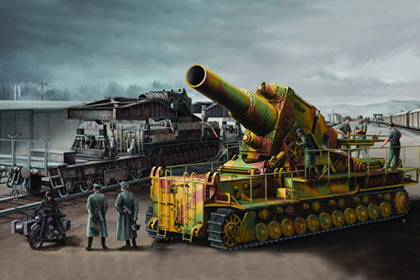
At a conference with Hitler in March 1943, it was stated that the first 54cm Gerät 041 would be delivered by June 1943, and the third, by mid-August. The 60cm and 54cm barrels appear to have been interchanged as required. In 1945, US forces captured vehicle II with a 60cm, and vehicle V with a 54cm. The prototype chassis, built in 1939, had eight road wheels with external swing arms. production Karl had eleven road wheels.
Ammunition was transported in a tracked Munitionsschlepper converted from the Pz.Kpfw.IV, four rounds in each Schlepper. For the 60cm Gerät 040, the s Be Granate weighed 2.117 tons and the Ie Be Granate, 1.70 tons; in this case of the 54cm Gerät 041, 1.58 tons and 1.25 tons respectively. Maximum rate of the fire was 6 rph (rounds per hour ). Guns I-IV went to the Russian Front in July 1941 with the 628th schwere Artillerie Abteilung.
They saw action at various sites, including Lemburg in that year. The best known action was against Sevastopol in 1942. Later, four guns were issued to the 833rd schwere Artillerie Abteilung (mot). These guns had the names Adam, Eve (1st Batt.) and Thor, Odin (2nd Batt.) The names for guns V and VI were Loki and Ziu.
This is the Trumpeter 01509 kit in 1/35 scale, of the ‘German Geschützwagen’.
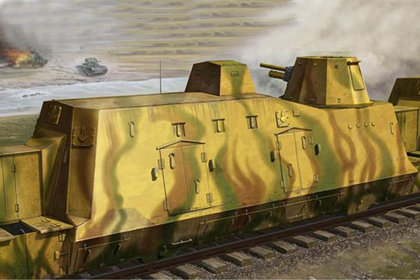
The two halves of the train, before and behind the locomotive were identical and consisted of one artillery car with one 10cm le.F.H 14/19(p) gun, one command and infantry car and one artillery and anti-aircraft car with one 7.62cm F.K.295/l(r) and one 2cm anti-aircraft quadruple unit.
This is the Trumpeter 00208 kit in 1/35 scale, of the ‘German Mörser Karl-Gerat 040/041 on railway transport carrier – Initial version’.
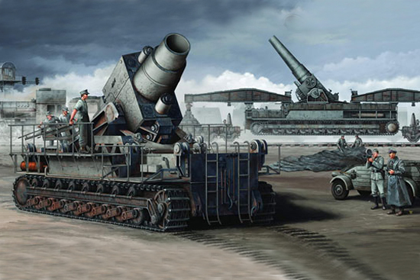
At a conference with Hitler in March 1943, it was stated that the first 54cm Gerät 041 would be delivered by June 1943, and the third, by mid-August. The 60cm and 54cm barrels appear to have been interchanged as required. In 1945, US forces captured vehicle II with a 60cm, and vehicle V with a 54cm. The prototype chassis, built in 1939, had eight road wheels with external swing arms. Production Karl had eleven road wheels.
Ammunition was transported in a tracked Munitionsschlepper converted from the PzKpfw IV, four rounds in each Schlepper. For the 60cm Gerät 040, the s Be Granate weighed 2.117 tons and the Ie Be Granate, 1.70 tons; in this case of the 54cm Gerät 041, 1.58 tons and 1.25 tons respectively. Maximum rate of the fire was 6 rph (rounds per hour). Guns I-IV went to the Russian Front in July 1941 with the 628th schwere Artillerie Abteilung. They saw action at various sites, including Lemburg in that year.
The best known action was against Sevastopol in 1942. Later, four guns were issued to the 833rd schwere Artillerie Abteilung (mot). These guns had the names Adam, Eve (1st Batt.) and Thor, Odin (2nd Batt.) The names for guns V and VI were Loki and Ziu.
This is the Trumpeter 00369 kit in 1/35 scale, of the ‘German Panzerjägerwagen, volume 2’.

It was the armored pursuit car replace by the earlier pusher car. That now gave the train an effective means of against Russian tanks. In this instance, a program of new construction had been planned in 1944 by German Army: 8 BP 44 armored trains.
This is the Trumpeter 00386 kit in 1/35 scale, of the ‘German Panzerjägerwagen, volume 1’.
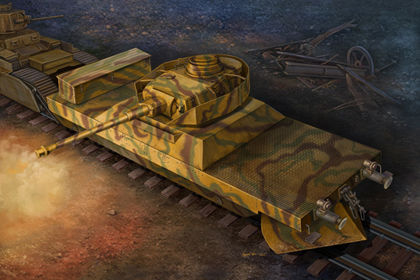
It was the armored pursuit car replace by the earlier pusher car. That now gave the train an effective means of against Russian tanks. In this instance, a program of new construction had been planned in 1944 by German Army: 8 BP 44 armored trains.